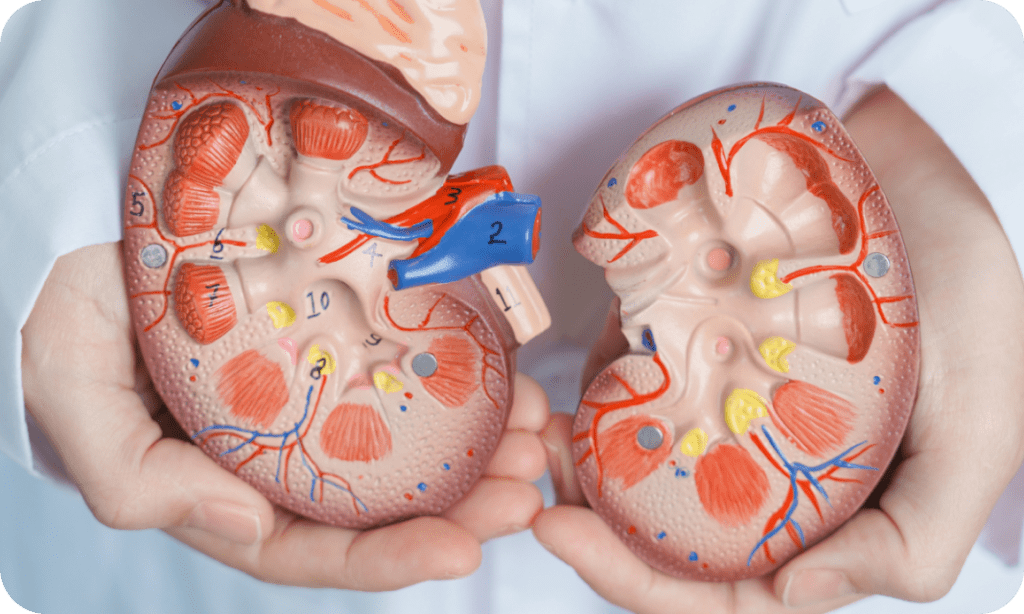Adrenal gland tumors are abnormal growths that form in the adrenal glands, which are located on top of each kidney. These glands produce important hormones, including cortisol, adrenaline, and aldosterone, which regulate various bodily functions such as metabolism, immune response, and blood pressure. Adrenal gland tumors can be benign (noncancerous) or malignant (cancerous). Some tumors may cause an overproduction of hormones, leading to a range of symptoms, while others may not produce any hormones (nonfunctional tumors).

Adrenal Gland Tumors
Detailed Information
The exact cause of most adrenal gland tumors is unknown, but certain risk factors and genetic conditions can increase the likelihood of developing these tumors:
1. Genetic Mutations: Inherited conditions like Multiple Endocrine Neoplasia (MEN1), Li-Fraumeni syndrome, and von Hippel-Lindau disease can raise the risk of adrenal tumors.
2. Family History: A family history of adrenal tumors or related genetic conditions may increase the likelihood of developing these tumors.
3. Age: Adrenal tumors can occur at any age but are more common in adults between 40 and 60 years old.
1. Genetic Mutations: Inherited conditions like Multiple Endocrine Neoplasia (MEN1), Li-Fraumeni syndrome, and von Hippel-Lindau disease can raise the risk of adrenal tumors.
2. Family History: A family history of adrenal tumors or related genetic conditions may increase the likelihood of developing these tumors.
3. Age: Adrenal tumors can occur at any age but are more common in adults between 40 and 60 years old.
There are different types of adrenal tumors, each with its unique characteristics:
1. Adenomas: These are noncancerous, hormone-producing tumors that often cause an overproduction of certain hormones.
2. Adrenocortical Carcinoma: A rare, aggressive cancer that begins in the outer layer of the adrenal gland and often causes hormone imbalances.
3. Pheochromocytomas: These tumors form in the adrenal medulla and cause the overproduction of adrenaline and noradrenaline, leading to high blood pressure.
4. Neuroblastomas: A rare cancer that develops in nerve tissue and often affects children.
1. Adenomas: These are noncancerous, hormone-producing tumors that often cause an overproduction of certain hormones.
2. Adrenocortical Carcinoma: A rare, aggressive cancer that begins in the outer layer of the adrenal gland and often causes hormone imbalances.
3. Pheochromocytomas: These tumors form in the adrenal medulla and cause the overproduction of adrenaline and noradrenaline, leading to high blood pressure.
4. Neuroblastomas: A rare cancer that develops in nerve tissue and often affects children.
Symptoms of adrenal gland tumors vary depending on whether the tumor is producing hormones. Common signs include:
• High Blood Pressure: Caused by overproduction of adrenaline or cortisol.
• Unexplained Weight Gain or Loss: Due to hormonal imbalances.
• Excessive Sweating or Heart Palpitations: Caused by the overproduction of adrenaline.
• Muscle Weakness: Particularly in the legs and arms.
• Facial Flushing and Anxiety: Due to increased hormone levels.
• Abdominal Pain or Fullness: Especially if the tumor is large.
If a tumor is nonfunctional (not producing hormones), it may not cause symptoms until it becomes large enough to press on nearby organs.
• High Blood Pressure: Caused by overproduction of adrenaline or cortisol.
• Unexplained Weight Gain or Loss: Due to hormonal imbalances.
• Excessive Sweating or Heart Palpitations: Caused by the overproduction of adrenaline.
• Muscle Weakness: Particularly in the legs and arms.
• Facial Flushing and Anxiety: Due to increased hormone levels.
• Abdominal Pain or Fullness: Especially if the tumor is large.
If a tumor is nonfunctional (not producing hormones), it may not cause symptoms until it becomes large enough to press on nearby organs.
There is no definitive way to prevent adrenal gland tumors, but you can reduce your risk by:
1. Genetic Counseling: If you have a family history of adrenal tumors or related syndromes, genetic testing and counseling may help assess your risk.
2. Routine Checkups: Early detection through regular medical checkups can help monitor hormone levels and detect any abnormalities early.
1. Genetic Counseling: If you have a family history of adrenal tumors or related syndromes, genetic testing and counseling may help assess your risk.
2. Routine Checkups: Early detection through regular medical checkups can help monitor hormone levels and detect any abnormalities early.
Book Your Consultation Now
Schedule an appointment with the leading uro-oncologist in Bangalore, Dr. Anil
Kumar T. Benefit from expert care and advanced treatment options for all your
urological needs, delivered with a patient-centered approach.

Resolve Your Queries
Answers to the most common inquiries about urological conditions, treatments, and patient care. Designed to offer quick guidance and help you better understand, ensuring you feel informed and confident in your healthcare decisions.
Still have queries about Urology & Uro Oncology? Hit the button below.
Accordion Tab Title 2
Lorem ipsum dolor sit amet, consectetur adipisicing elit. Optio, neque qui velit. Magni dolorum quidem ipsam eligendi, totam, facilis laudantium cum accusamus ullam voluptatibus commodi numquam, error, est. Ea, consequatur.
Accordion Tab Title 3
Lorem ipsum dolor sit amet, consectetur adipisicing elit. Optio, neque qui velit. Magni dolorum quidem ipsam eligendi, totam, facilis laudantium cum accusamus ullam voluptatibus commodi numquam, error, est. Ea, consequatur.
Visit Us
Zymus Hospital Address
No.1, K NO. 92, Nanjappa Complex, Kanakapura Rd, Raghuvanahalli, Bangalore City Municipal Corporation Layout, Bengaluru, Karnataka 560062
Menu
Menu
Quick Links
Menu
Copyright © 2024. Dr Anil Kumar T

